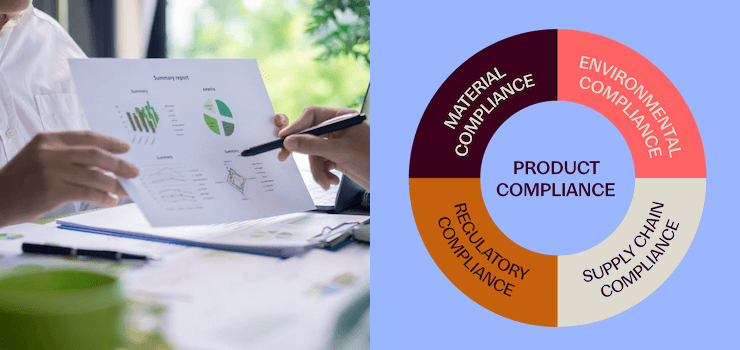Per- and polyfluoroalkyl substances (PFAS) have gained global attention due to their widespread use and potential effects on human health and the environment. In the European Union (EU), regulating these chemicals has been a priority to safeguard public health and the environment. From being recognized as persistent organic pollutants (POPs) to being included in REACH, the path of PFAS regulation in the EU has evolved rapidly. It is therefore crucial for companies to keep up to date with these ongoing developments.
PFAS Explained: Origins and Concerns
Per- and polyfluoroalkyl substances (PFAS) are a group of man-made chemicals that have been widely used in various industrial and consumer products for decades. They are valued for their unique water and oil repellent properties, heat resistance, and durability. PFAS can be found in products like non-stick cookware, waterproof clothing, food packaging, and firefighting foams.
However, the use of PFAS has raised concerns due to their persistence in the environment, bioaccumulative nature, and potential health risks. PFAS have been linked to adverse health effects, including developmental problems, immune system disorders, and an increased risk of cancer. Their ability to persist in the environment for long periods without breaking down further compounds the concerns, leading to regulatory actions aimed at controlling their use and minimizing exposure.
How PFAS are regulated in the EU
The European Union has implemented a comprehensive regulatory framework to manage the risks associated with PFAS. This framework includes stringent measures under various regulations aimed at protecting human health and the environment. Key regulatory approaches include the Persistent Organic Pollutants (POPs) Regulation, CLP and the REACH Regulation.
Regulation through POP
The European Union has been at the forefront of regulating PFAS through the Persistent Organic Pollutants (POPs) Regulation, aligned with the international commitments under the Stockholm Convention. Since 2009, perfluorooctane sulfonic acid (PFOS) and its derivatives have been included in the Stockholm Convention, aiming for their global elimination.
Building on this framework, the Stockholm Convention also targets the elimination of perfluorooctanoic acid (PFOA), its salts, and PFOA-related compounds. These substances have been banned under the EU's POPs Regulation since July 4, 2020, marking a critical step in mitigating their risks.
In a continued effort to address PFAS pollution, the Stockholm Convention parties decided in June 2022 to include perfluorohexane sulfonic acid (PFHxS), its salts, and related compounds in the treaty. The European Commission promptly added this substance group to the EU's POPs Regulation in May 2023, with the regulation coming into force on August 28, 2023.
Moreover, long-chain perfluorinated carboxylic acids (C9-21 PFCAs) are under consideration for inclusion in the Stockholm Convention, which would lead to their global elimination. These steps illustrate the EU's proactive stance in regulating harmful PFAS through the POPs framework.
Classification under the CLP Regulation
Many PFAS subgroups are already governed by the CLP Regulation (Classification, Labeling and Packaging) to ensure the safe use and packaging of these chemicals. PFOA and the ammonium salt APFO, C9 and C10 PFCAs and their sodium and ammonium salts, PFHpA (from November 23, 2023), and PFOS and their lithium, sodium, ammonium and diethanolamine salts are listed in Annex VI of the CLP Regulation due to their reproductive toxicity and carcinogenic properties. These substances are subject to EU-wide harmonized classification and labelling in order to provide comprehensive information on their safe use.
New regulations through REACH - ECHA publishes PFAS restriction proposal
The EU is advancing its regulatory efforts on PFAS through the Registration, Evaluation, Authorisation and Restriction of Chemicals (REACH) regulation. This comprehensive approach aims to address the extensive use and persistent nature of PFAS in various sectors.
In February 2023, a proposal to restrict over 10,000 PFAS was submitted by the national authorities of Denmark, Germany, the Netherlands, Norway, and Sweden. This proposal includes two main restriction options: a full ban (RO1) and a ban with use-specific derogations (RO2). The full ban option (RO1) would have an 18-month transition period before taking effect. The ban with use-specific derogations (RO2) would also have an 18-month transition period, followed by derogation periods of up to five or twelve years for specific uses where alternatives are not yet feasible.
The European Chemicals Agency's (ECHA) Scientific Committees for Risk Assessment (RAC) and Socio-Economic Analysis (SEAC) are currently evaluating the proposal. They are also considering the feedback from public consultations and will provide their opinions on the restriction. The assessment focuses on various sectors impacted by PFAS, aiming to balance environmental protection with economic operability.
Strategic Planning for PFAS Compliance: Implications for EU Businesses and Companies
The evolving regulatory landscape for PFAS in the EU presents significant challenges and opportunities for companies selling products within this market. With the new REACH PFAS regulations still in development, businesses must navigate a period of uncertainty and prepare for substantial changes in compliance requirements.
Those companies that proactively begin adopting safer alternatives to PFAS can gain a competitive edge, ensuring continued market access and building a reputation for environmental responsibility, as the proposed REACH restrictions include two main options: a full ban and a ban with specific derogations. Companies lagging in this transition may face disruptions, increased costs, or even market exclusion if their products fail to meet the new standards.
The impact extends beyond individual companies to the broader supply chain and market dynamics. Suppliers of raw materials and components containing PFAS must also align with the new regulations, which may lead to supply shortages or increased costs for compliant materials. Companies need to work closely with their supply chains to ensure that all components meet the upcoming standards, fostering greater transparency and collaboration across the industry.
Our Solutions for PFAS Compliance
Navigating the complex landscape of PFAS regulations requires robust and reliable solutions. Our comprehensive services are designed to help manufacturers stay ahead of regulatory changes and ensure PFAS compliance with the latest and upcoming requirements.
Expert-Edited and Monitored Substance List
We offer an extensive list of PFAS substances compiled from reliable sources and continuously updated by our team of experts. This ensures that your products are always aligned with the most current PFAS compliance regulations and reporting rules.
Categorized Substance Assignment
To enhance transparency, we categorize substances based on their chemical structure. This systematic grouping helps you understand the implications of expected regulations more clearly, enabling a proactive approach to managing full or partial bans. Our categorized assignment simplifies the compliance process, allowing for more efficient decision-making and strategic planning.
Extensive Analysis for Identifying Hotspots
Our services include detailed analytical data to identify PFAS hotspots within your products and supply chain. We use advanced predictive tools and what-if scenarios to provide a comprehensive understanding of potential impacts. This analytical approach aids in structuring effective supply chain communication and risk management strategies, ensuring your business is well-prepared for any regulatory changes.
By utilizing our solutions for PFAS compliance, you can ensure that your operations remain compliant with the evolving PFAS regulations. Our expert guidance, systematic categorizationand analysis provide the insights and support needed to navigate this challenging regulatory environment effectively.





.png)
